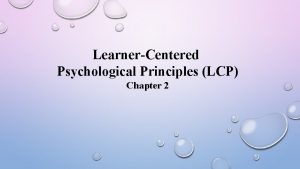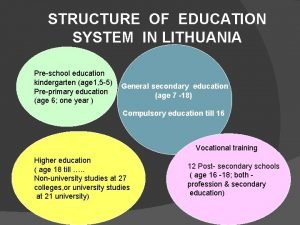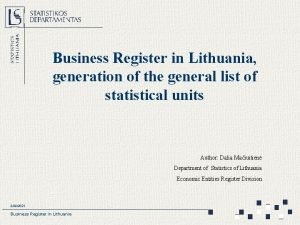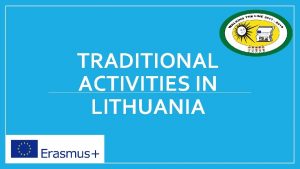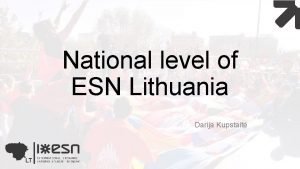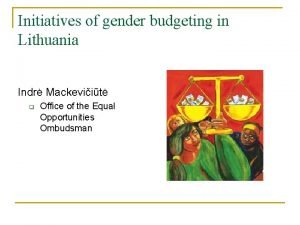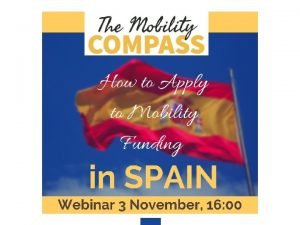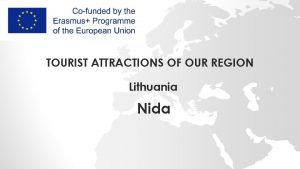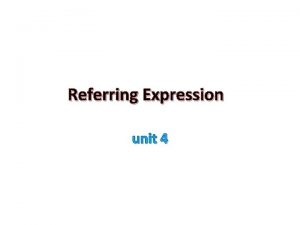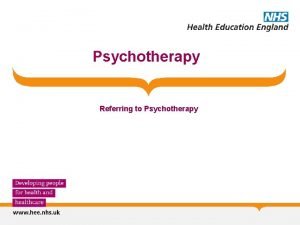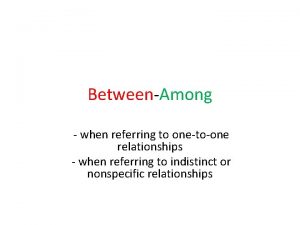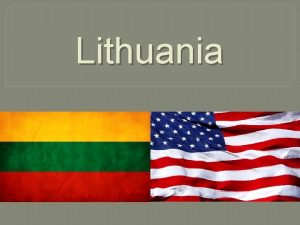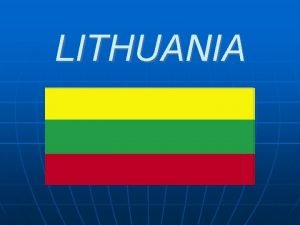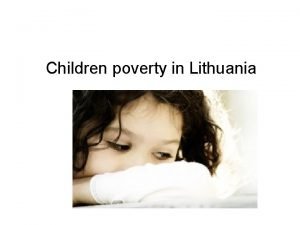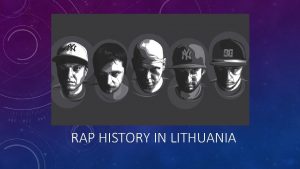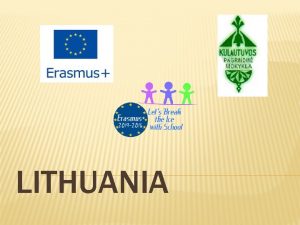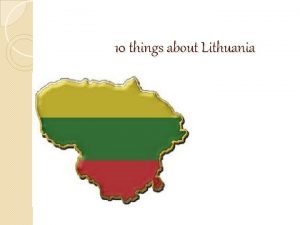The experience of Lithuania in identifying and referring



















- Slides: 19

The experience of Lithuania in identifying and referring children at risk of exploitation and trafficking GOOD PRACTICES IN IDENTIFICATION AND REFERRAL OF CHILDREN AT RISK OF EXPLOITATION AND TRAFFICKING Vilnius, 12 and 13 December 2017 Dr. Karolis Žibas Lithuanian Social Research Centre Institute for Ethnic Studies

Are we able to protect our children? Structural factors and form of exploitation • Poverty and exclusion • Gender inequality, domestic violence and education • THB, emigration and immigration

In 2016, 21. 9% Lithuania’s population were living below the at-risk-of-poverty threshold “When a person, especially from a socially at-risk family, when she is told that her bathroom will be normal, that she will even go abroad, she does not hear, she does not see, it is most important for her to escape those drunkards, rapists. Also for those living in a foster home, it is important to say, I lived in UK. That is a rise in status. ” (N: 27 July 2015) Statistics Lithuania, 11. 08. 2017

Lithuania’s population at-risk-of-poverty by age Poverty in Lithuania is not the same as in Sweden or UK Date 2015 2014 2013 2012 2011 2010 2009 2008 2007 2006 2005 under 18 28. 9% 23. 5% 26. 9% 20. 8% 25. 2% 24. 8% 23. 3% 22. 1% 25. 1% 27. 2% from 18 to 64 65 and over risk of poverty 19. 5% 25. 0% 22. 2% 17. 6% 20. 1% 19. 0% 19. 4% 20. 6% 17. 9% 18. 7% 18. 6% 20. 2% 9. 7% 19. 2% 22. 2% 9. 6% 20. 5% 18. 4% 23. 9% 20. 3% 17. 5% 31. 0% 20. 9% 15. 6% 29. 8% 19. 1% 17. 8% 22. 0% 20. 0% 19. 0% 17. 0% 20. 5%

Population at risk of poverty or social exclusion, by age group, 2015, % “We had a case in Lithuania in which the parents sold their daughter for 600 litas [~174 euros] to a Ukrainian guy and he left for Germany. The parents said, ‘she will get married, so what? ’ They get money. They got married and immediately after the ceremony, he left Lithuania. ” (N: 27 July 2015)

Children at risk of poverty, 2010 and 2015 The most relevant individual risk factors of potential victims-children are directly related to family factors, such as family structure, household socio-economic status and poverty, relationship with parents and parental monitoring (Žibas 2015, 2016) EUROSTAT

Population at risk of poverty or social exclusion, by household type, EU-28, 2015 “They take [people] from villages, families with large sizes, and young single mothers with young children. They live in a small village of the region and here they are being given an offer to go abroad. She may not have been beyond Vilnius and here she is given an offer to go abroad – it looks very enticing. Everything is much simplier. ” (P: 16 July 2015) EUROSTAT

Perception of poverty and attitudes towards victims: exploitation of vulnerability is not an argument? “We had a court decision last summer. The criteria of vulnerability was argued using the fact that the victim does not have a job and does not have a place to live, poor education, parents in jail, life in orphanages, the father a former prisoner. The victim was taken from an orphanage, conflicts started at home again. Eventually the victim was kicked out of her home. Not having a place to live, slept under balconies, did some occasional work for farmers and so forth. And this is how I tried to prove vulnerability to the court, using this aspect, but the court said, what kind of vulnerability is this? This is how most residents in the countryside live, this is not any kind of vulnerability. ” (P: 21 September 2015)

Indicators of educational outcomes and attitudes towards victims: in/out family environment Usually trafficked children come from both disrupted families and economically deprived households. In both instances, the most relevant risk factors are the lack of attention and parental unconcern, usage of alcohol and sexual exploitation, domestic violence and poverty (2015, 2016). There are cases, when law enforcement institutions, school community, practitioners are considering children as (potential) offenders, instead of (potential) victims (2015). It prevails in other forms of exploitation.

Poverty, gender inequality and education On the top of poverty and exclusion, the concept of the traditional family and to the role of women in the family and in society come into play “They all remain at risk and that condition becomes normalised. For example, a girl who married – she had never seen a model of a family. She was always told, it was explained to her, an environment of a small town, that a woman must fulfil her duties – prepare the food, tidy the rooms, give birth to children, satisfy her husband. And how do you tell her that she is forced to do that if it already flows in her blood that she has to do it. She does not know of any alternative. ” (N: 16 July 2015)

From child to adult: (structural) gender inequality and education Children from child welfare institutions or orphanages understand neither the consequences of gender inequality nor recognise the forms of exploitation “Life is such: she receives social welfare payments, her boyfriend, much older than she, his father and brother also live there. His [the boyfriend’s] brother is even older, the father drinks a lot, . . . she is receiving the money, she simply does housework, cleans up and she also gives them the money. Forced marriage – not yet. Of course, she will get pregnant soon, maybe will even get married, will live there and will be imprisoned. But how to identify and pull her out, if she says, ‘I love him and I want to live with him, it is ok the way it is’. Social pedagogues will say that they have done everything they can do and all they can do now is to observe, as she is swearing to God that everything is fine, she is the happiest person on earth, the most loved. ” (N: 16 July 2015)

The most vulnerable ones and interconnection of risk factors History of psychological, physical and/or sexual abuse and general risk -behaviour – potential of THB Interconnection: when due to emotional or cognitive disorders, potential victims are showing general risk-behaviour or due to physical and/or sexual abuse they have certain emotional or cognitive disorders. Tolerance of violence against women, youth and children, tolerance of sexual violence and tolerance for inequality and gender discrimination are those structural factors, which affect and increase the likelihood of THB.

THB, minorities, emigration and immigration: are we able to protect our children? • Roma children • Unaccompanied minors from Vietnam • Refugee / immigrant children • Lithuania in the context of international migration

THB as a political priority? ? ? “This is only the tip of the iceberg. We see very little, … the scope is big and we see only the tip of iceberg. ” “If there were more officers … there would be more cases started … no doubt. ” (P: 21 September 2015)

Recommendations • Long-term strategy – political priority – better coordination • More effective victim referrals mechanism • More training less prejudices and stereotypes • More funding and human recourses – more cases – bigger priority • Less poverty and exclusion, less victims (re-victimisation) • More gender equality – less domestic violence and (sexual) exploitation – less internal/external trafficking • Dealing with consequences – better international cooperation • Seeking better prevention – going out from the comfort zone and thinking outside the box • Trafficking to Lithuania VS trafficking from Lithuania • Mainstreaming anti-trafficking efforts to different governmental strategies

? “Victims of sexual violence. Here comes a young woman. . . she was raped when she came home on the last bus, she was walking down the path, it seems somewhere on the outskirts of a forest. A car stopped, she was dragged into the car and gang raped. She came to write her statement and she was told, ‘child, where were you going at night? How were you dressed? A short summer skirt? ’… The investigator is asking these questions. . . ” (N: 16 July 2015)

The most important local level services Access to protection and support services (in cases of victim support and re-victimisation); Access to proximity police services (in cases of identifying cases of THB and protecting/helping to escape from THB); Access to an effective legal guardianship system (in cases of protecting the victim of THB and re-victimisation); Access to adequate education services (in cases of helping potential victims to escape from THB, re-victimisation and protection of the victim); Access to adequate health care services is also in need, but to a lesser extent in both cases: help children escape THB or revictimisation.

The most important local level services In addition, interviews indicated such services: Awareness raising/information campaigns among social workers and psychologist in schools, representatives of law enforcement institutions and municipalities. To reduce stereotypes and prejudices in order to help the most risky groups of children not to become victims of human trafficking or not to be re-victimised. To strengthen the monitoring mechanisms of the most risky groups of children, especially in periphery and deprived areas, where poverty, social exclusion and highest socioeconomic inequality exist.

Intervention strategies against trafficking and related risks for children at the grass root/community level are the most important ones Awareness raising campaigns for children, local practitioners, law enforcement and other institutions at the local level; Interventions in the general education system by establishing horizontal measures of awareness raising, especially in deprived areas (for example, instead of fragmented project-based education campaigns there is a need to introduce long-term campaigns for all practitioners, working with human trafficking at the local level: schools, shelters, children houses, police, etc. ); To educate practitioners and other experts working in an area of THB (schools, shelters, children houses, police, etc. ); Education on online safety was also indicated as important initiative as it play significant role in involving children in human trafficking.
 Identifying and non identifying adjective clauses
Identifying and non identifying adjective clauses Adjective clause identification
Adjective clause identification Information essential
Information essential Direct and indirect experience examples
Direct and indirect experience examples Imprinting meaning psychology
Imprinting meaning psychology Early experience vs later experience debate
Early experience vs later experience debate 14 lcp principles
14 lcp principles Proclaiming and referring tones
Proclaiming and referring tones Famous places in lithuania
Famous places in lithuania Secondary school grading system
Secondary school grading system Lithuania business register
Lithuania business register Popular sports in lithuania
Popular sports in lithuania Dmc in lithuania
Dmc in lithuania Esn lithuania
Esn lithuania Budgeting in lithuania
Budgeting in lithuania Lithuania cruise port
Lithuania cruise port Lithuania christmas tree
Lithuania christmas tree Rural tourism in lithuania
Rural tourism in lithuania Lithuania jega results
Lithuania jega results Nida lithuania map
Nida lithuania map






